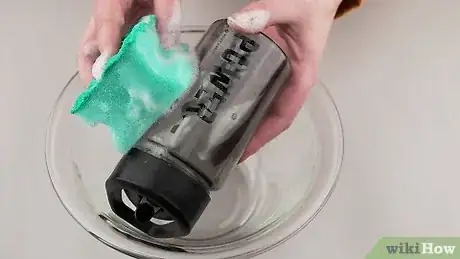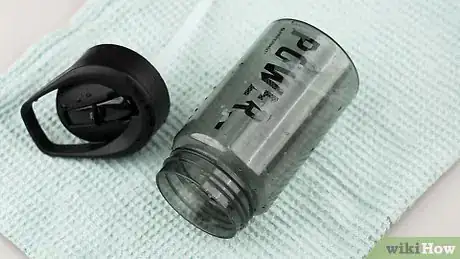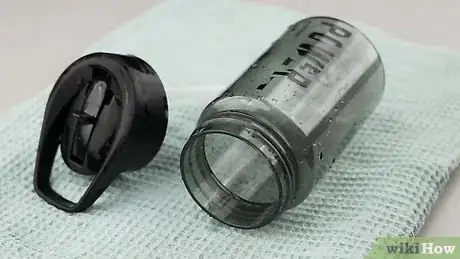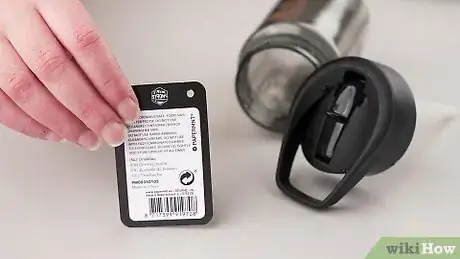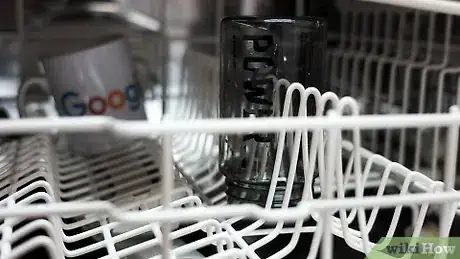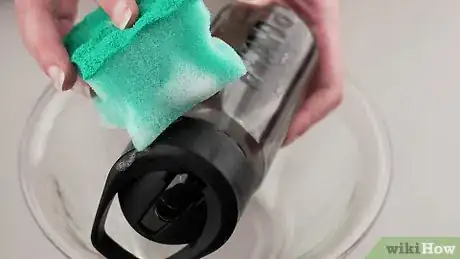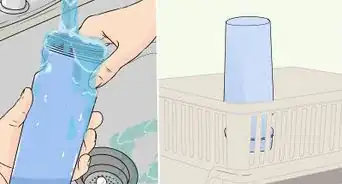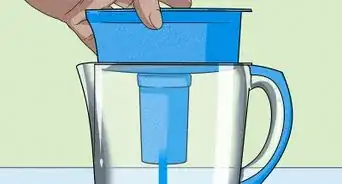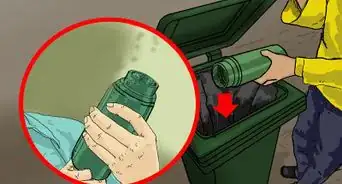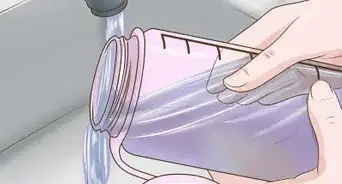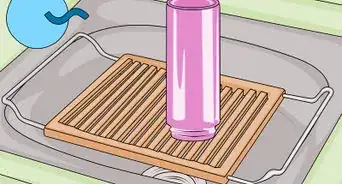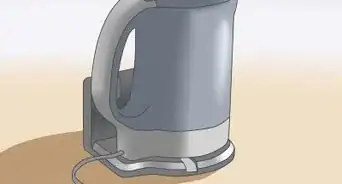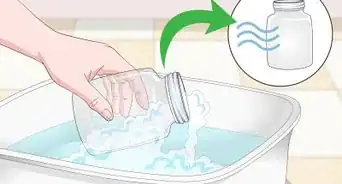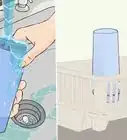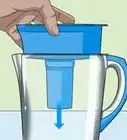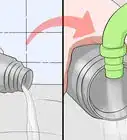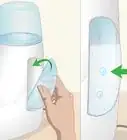This article was co-authored by wikiHow Staff. Our trained team of editors and researchers validate articles for accuracy and comprehensiveness. wikiHow's Content Management Team carefully monitors the work from our editorial staff to ensure that each article is backed by trusted research and meets our high quality standards.
The wikiHow Video Team also followed the article's instructions and verified that they work.
This article has been viewed 18,984 times.
Learn more...
Having a water bottle is great, as it gives you easy access to fresh water on the go. But you may not realize that your water bottle can actually get dirty, especially if you have not cleaned it lately. The moist environment of your water bottle can be a breeding ground for germs, which you then swallow along with your water. To clean your water bottle, you can use soap and water or vinegar. You can also put the water bottle in the dishwasher to clean it.
Steps
Using Soap and Water
-
1Clean the bottle with soap and water. Mild soap and warm water can be a great cleaning option for your water bottle. Use a cloth or a sponge to clean the bottle with a few dabs of soap under running warm water. Make sure you clean the cover or top of the water bottle as well as the mouth of the water bottle and the inside of the bottle. Wipe the bottle inside and out in a circular motion a few times to really clean it well.[1]
- You can also pour the soap and water in the bottle and shake the bottle around a few times with the lid on to clean it.
-
2Scrub the bottle with a brush. To give the bottle a deep clean, scrub the inside and outside of the bottle with a small cleaning brush. Dip the brush in soap and water to clean the bottle. Make sure you scrub the inside of the bottle, including the mouth of the bottle, as that is where germs usually sit.[2]
- You can also use a clean toothbrush to scrub the bottle in a pinch.
Advertisement -
3Rinse out the bottle. Once you have cleaned and scrubbed the bottle, make sure you rinse it out with warm water. Run the bottle under running water a few times to remove any remaining soap.[3]
- You can also fill up the bottle with water and dump it out a few times to make sure no more soap is left in it. You do not want your water tasting like soap the next time you sip from the bottle.
-
4Let the bottle air dry. Place the water bottle on a drying rack or upside down on a clean towel. Let it air dry overnight so it is fresh and ready to use in the morning.[4]
- Get into the habit of washing your water bottles once a day or once every two days, especially if you use them often. This will ensure no germs buildup in the bottle and contaminate your water.
Cleaning With Vinegar
-
1Soak the bottle in a vinegar solution. To clean and disinfect your water bottle, try soaking it in a mixture of white vinegar and water. Mix one part vinegar with one part water in a bowl. Then, submerge the water bottle in the solution, making sure the solution gets inside the water bottle. Let the bottle soak for one to two minutes.[5]
- Another option is to fill the bottle with the vinegar and water solution. Then, let the solution sit in the bottle for one to two minutes.
-
2Scrub the bottle with a brush or a sponge. Once you have soaked the bottle, rinse out the solution. Then, use a damp brush or a sponge to scrub the bottle. Make sure you scrub the mouth and lid of the bottle well, as this is usually where germs live.[6]
- Scrubbing the bottle will also help to remove any remaining vinegar in the bottle.
-
3Dry the bottle. Let the water bottle air dry on a drying rack or a clean towel overnight. If you are in a rush, you can use a clean cloth to dry the bottle. Make sure you dry the mouth and lid of the bottle well.
Putting the Water Bottles in the Dishwasher
-
1Check that the bottle is dishwasher safe. Most water bottles made of metal, stainless steel, and glass are dishwasher safe. Check the label on the bottle to make sure it is safe to put in the dishwasher.[7]
- If the water bottle is made of plastic, it may not be dishwasher safe. Putting it in the dishwasher can warp or damage the plastic.
-
2Put the bottle in the dishwasher. Place the water bottle in the dishwasher, separating the lid from the bottle. Put the bottle on the dishwashing rack upside down, with the mouth facing downward.[8]
- Run the bottle through the dishwasher on the gentle or normal cycle. The cycle should include a drying phase, where the bottle is dried well in the dishwasher.
-
3Clean the bottle regularly. To avoid the buildup of germs and bacteria, get in the habit of cleaning the bottle every few days. Run the water bottle through the dishwasher every few days or at the end of every day, especially if you use it on a daily basis. This will help to keep the bottle clean and ensure you are drinking fresh, germ free water every day.[9]
References
- ↑ https://www.ahealthiermichigan.org/2014/09/15/the-right-way-to-care-for-your-reusable-water-bottle/
- ↑ http://www.bicycling.com/maintenance/tips/7-tips-cleaning-your-cycling-water-bottles
- ↑ https://www.ahealthiermichigan.org/2014/09/15/the-right-way-to-care-for-your-reusable-water-bottle/
- ↑ https://www.ahealthiermichigan.org/2014/09/15/the-right-way-to-care-for-your-reusable-water-bottle/
- ↑ http://www.huffingtonpost.com/entry/wait-youre-supposed-to-wash-your-water-bottle-how-often_us_57a357b2e4b04414d1f3bf3a
- ↑ http://www.huffingtonpost.com/entry/wait-youre-supposed-to-wash-your-water-bottle-how-often_us_57a357b2e4b04414d1f3bf3a
- ↑ http://www.today.com/home/step-step-guide-how-clean-reusable-water-bottles-t76946
- ↑ https://www.ahealthiermichigan.org/2014/09/15/the-right-way-to-care-for-your-reusable-water-bottle/
- ↑ https://www.ahealthiermichigan.org/2014/09/15/the-right-way-to-care-for-your-reusable-water-bottle/
About This Article
To clean water bottles, fill the bottle halfway with soap and water, put the lid on, and shake vigorously. Alternatively, if you want to clean and disinfect your bottle, soak it in a mixture of vinegar and water. Then, after 2 minutes, rinse the solution out of the bottle with clean water. No matter which method you choose, pay extra attention to the mouth and lid of the bottle since this is where a lot of germs live. Allow the bottle to air dry on a drying rack or towel overnight, or, if you’re in a rush, use a cloth to dry the bottle. For tips on dishwashing water bottles, keep reading!
